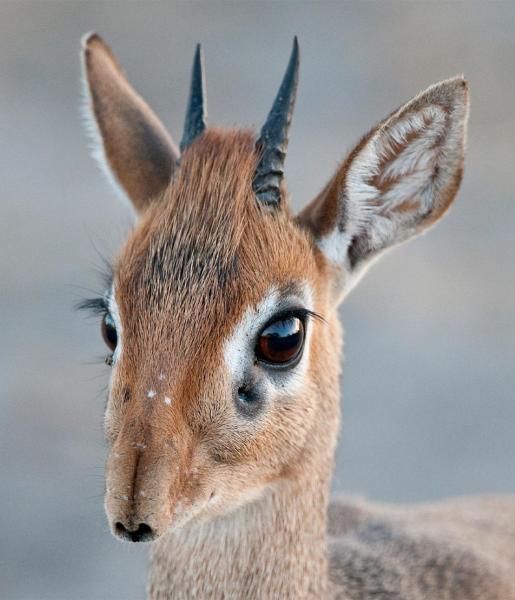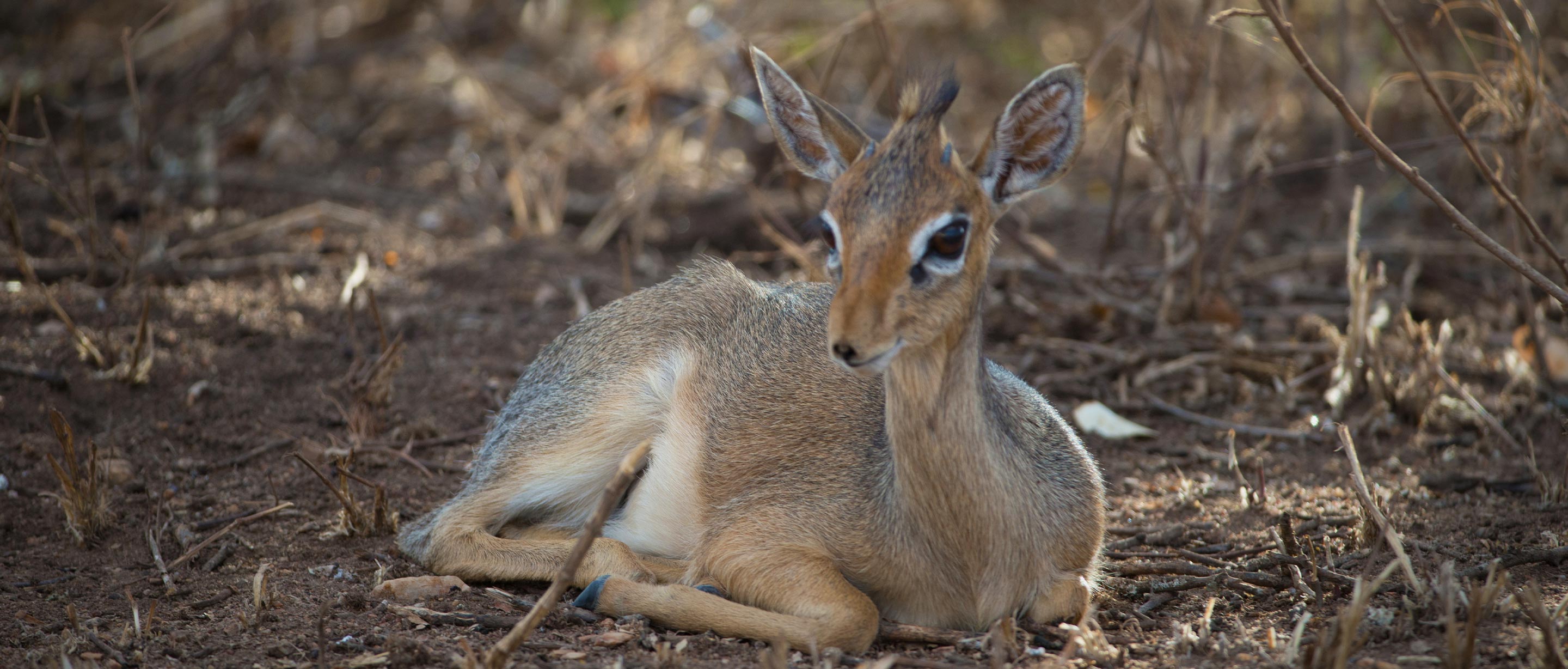What are dik-diks?
Kirk’s dik-diks are tiny antelopes that vary in color depending on their habitat but are typically yellowish-gray to reddish-brown on its back and grayish-white on their belly. Males have horns that are ringed and stout at the base, which are often concealed by a tuft of hair on their forehead. These antelopes have beautiful, large, dark eyes surrounded by a white ring. And while their eyes are stunning, they provide more than just sight. Preorbital glands appear as a black spot below the inside corner of each eye. These glands produce a dark, sticky secretion used to scent-mark their territories.
The most distinguishing feature is their elongated snout, which is also an evolved cooling mechanism that stops them from overheating, even in extreme temperatures of up to 40°C (104°F). This also helps minimize their need for water.
Madoqua kirkii
3 to 6 kilograms (6 to 13 pounds)
30 to 40.5 centimeters at the shoulder (12 to 16 inches) 52 to 67 centimeters in length (20 to 26 inches)
No data for in the wild; approximately up to 17 years in captivity.
Ranges from arid, dense thorn scrub to thickets and open woodland, riverine woodlands, and open plains.
Herbivorous
5 to 6 months
Humans, many small carnivores

Challenges
Dik-diks do not deserve to end up as jewelry or gloves.
People are the biggest threat to this species and have long hunted them, setting snares along their paths. Small bones from their legs and feet are used in traditional jewelry. Their skins are often made into suede for gloves. One hide is equivalent to one glove.
Expansion of agricultural settlement forces dik-diks to exist in unconventional conditions.
There are an estimated 971,000 or more individuals. The population trend is stable over large parts of their range but is decreasing in some densely settled areas. While there aren’t many obvious major threats to this species, the expansion of agricultural settlements and human populations affect their populations. However, their populations have become resilient to the vegetation changes that have accompanied human growth and can exist in scrub and in over-grazed areas.
Solutions
Our solutions to protecting the dik-dik:
We are also equipping park staff, including wardens and rangers, with the technology they need to monitor the park and help protect these animals from threats.
With the strategic support of African Wildlife Foundation, the Entonet/Elerai Maasai community opened Satao Elerai, a luxury lodge situated on 5,000 acres of land in Southern Kenya. Revenue from the lodge is reinvested into supporting the community and conserving wildlife such as the dik-dik.


Behaviors
Dik-diks survive by hiding.
This antelope is shy and elusive, concealing themselves in brush most of the time. They have well-developed sight, scent, and hearing. When dik-diks feel they’re in danger or hear the alarm calls from other animals, they hide instead of fleeing from predators. And when frightened or disturbed, they make a whistling sound through their nose that sounds like “zik-zik,” and this is probably how they got their name.
These antelopes mate for life and live together in low bush areas along dry, rocky stream beds. They are rarely seen apart from their partners. Mostly nocturnal, they avoid the heat of the day; this also helps them prevent unnecessary water loss.
Diet
Thanks to an evolved cooling mechanism, dik-diks are water-independent.
Because of their body’s evolved cooling ability, they are water-independent, getting water from the vegetation they eat — such as foliage, shoots, fruit, and berries. This small antelope’s metabolic requirement per kilogram is so high that it must consume more food per kilogram of its body weight than their larger hoofed mammal cousins.
Habitats
Where do dik-diks live?
This species remains widespread throughout much of its historical distribution. Kirk’s dik-diks occur in two separate regions: East Africa, from southern Somalia to central Tanzania and in Southern Africa from northern Namibia and parts of southwestern Angola. They tend to live in habitats with good cover but without tall herbage. They move to different ranges when grass grows too high and obstructs their view.



